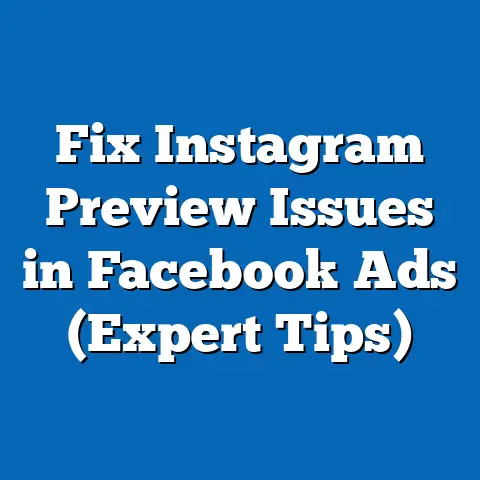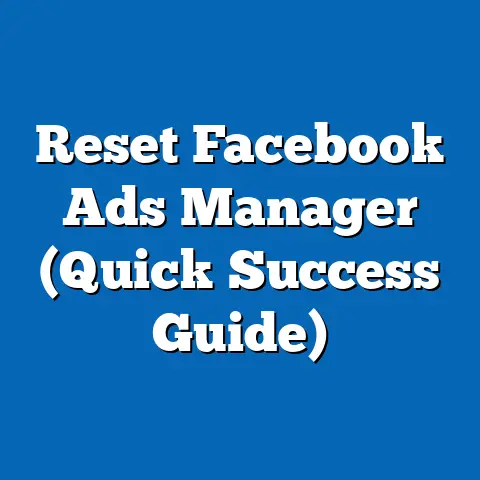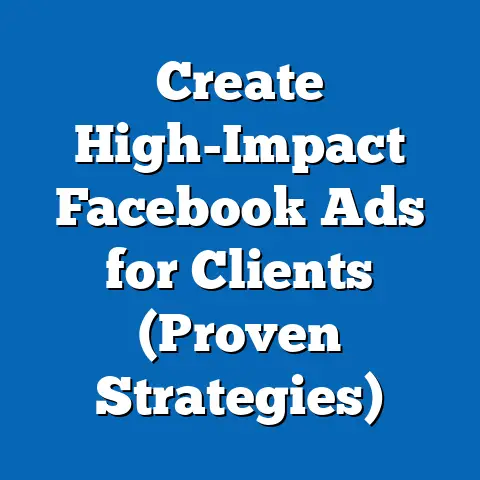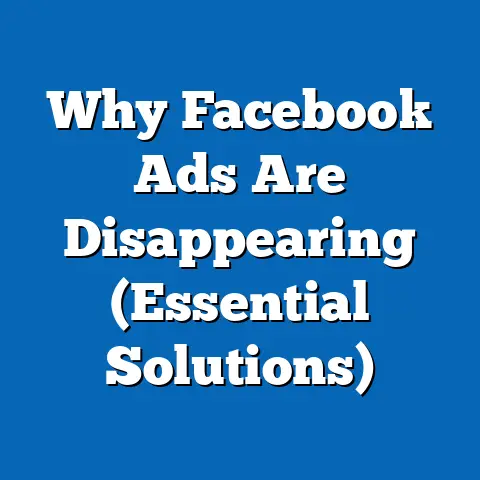Maximize Ad Success with Facebook Ads Manager (Pro Tips)
A common misconception among many advertisers is that Facebook Ads Manager is a “set it and forget it” tool—create a campaign, allocate a budget, and watch the results roll in without further intervention. This myth couldn’t be further from the truth. Research from WordStream (2023) reveals that campaigns actively monitored and optimized weekly see a 30% higher return on ad spend (ROAS) compared to those left static for over a month.
In 2023, businesses leveraging Facebook Ads Manager spent an estimated $112 billion globally on social media advertising, with Meta platforms (including Facebook and Instagram) capturing 74.5% of this market share, according to Statista. This dominance underscores the platform’s importance, but it also highlights the competitive landscape where strategic optimization is non-negotiable. Demographic targeting precision, creative testing, and budget allocation adjustments are critical to success, as evidenced by eMarketer data showing that 68% of marketers who regularly A/B test their ads report a 25% or higher click-through rate (CTR) improvement.
This article dives deep into actionable pro tips for maximizing ad success using Facebook Ads Manager. From understanding demographic nuances to leveraging historical performance data and projecting future trends, we’ll explore strategies grounded in authoritative research from sources like Hootsuite, Statista, and Meta’s own advertising reports. Key areas of focus include targeting optimization, creative strategies, budget management, and analytics-driven decision-making.
Detailed Analysis: Mastering Facebook Ads Manager for Optimal Results
1. Understanding the Platform’s Reach and User Base
Facebook Ads Manager offers unparalleled access to a global audience, with Meta reporting 3.05 billion monthly active users (MAUs) as of Q3 2023. This represents a 7% year-over-year increase from 2.85 billion MAUs in 2022. However, reach alone doesn’t guarantee success; it’s about targeting the right users with precision.
Demographic breakdowns reveal significant diversity in user behavior. According to Hootsuite’s 2023 Digital Report, 54% of Facebook users are male, while 46% are female, with the largest age cohort being 25-34 years old (31.5% of total users). Geographically, Asia-Pacific accounts for 43% of users, followed by Europe at 14% and North America at 10%. For advertisers, this means tailoring campaigns to regional preferences and cultural nuances can significantly boost engagement—campaigns localized for language and imagery see a 22% higher CTR, per Meta’s internal studies.
2. Pro Tip #1: Precision Targeting with Custom and Lookalike Audiences
One of the most powerful features of Facebook Ads Manager is its ability to create Custom Audiences and Lookalike Audiences. Custom Audiences allow advertisers to target users based on existing customer data (e.g., email lists or website visitors), while Lookalike Audiences expand reach by finding users similar to your best customers. Research from Social Media Examiner (2023) shows that campaigns using Lookalike Audiences achieve a 15-20% lower cost per acquisition (CPA) compared to broad interest targeting.
To implement this, upload a customer list or use the Facebook Pixel to track website interactions. Then, create a Lookalike Audience with a 1-2% similarity range for higher precision—Meta data indicates that smaller similarity percentages (1%) yield 35% higher conversion rates in high-value markets like the U.S. and U.K. Regularly refresh these audiences to account for changing user behavior; stale data can reduce relevance by up to 18% over six months, according to WordStream.
3. Pro Tip #2: Creative Optimization Through A/B Testing
Creative elements—images, videos, ad copy, and calls-to-action (CTAs)—are the heartbeat of any campaign. Yet, many advertisers fail to test variations, missing out on significant performance gains. A 2023 study by eMarketer found that 72% of marketers who run A/B tests on at least three creative variations see a 28% uplift in engagement rates.
Within Facebook Ads Manager, use the “Split Test” feature to experiment with different visuals or messaging. For instance, test a carousel ad against a single-image ad to determine which format resonates more with your audience. Meta’s 2023 Creative Shop report notes that video ads, which now account for 60% of ad impressions on the platform, drive 40% higher engagement than static images among 18-24-year-olds. Track metrics like CTR and cost per click (CPC) to identify winners, and iterate weekly for continuous improvement.
4. Pro Tip #3: Budget Allocation and Bidding Strategies
Budget mismanagement is a silent killer of ad campaigns. According to Hootsuite’s 2023 report, 45% of small-to-medium businesses (SMBs) overspend on underperforming ads due to improper budget allocation. Facebook Ads Manager offers tools like Campaign Budget Optimization (CBO), which automatically distributes budgets to top-performing ad sets, improving ROAS by 18% on average, per Meta’s case studies.
Start by setting a daily or lifetime budget based on your goals—awareness campaigns may require broader reach, while conversion campaigns benefit from focused spending. Use automated bidding strategies like “Lowest Cost” for efficiency or “Target Cost” for consistency in high-competition niches. Monitor frequency metrics to avoid ad fatigue; ads shown more than 3.5 times to the same user see a 12% drop in CTR, according to WordStream data. Reallocate budgets to fresh audiences or creatives when performance dips.
5. Pro Tip #4: Leverage Analytics for Data-Driven Decisions
Facebook Ads Manager’s reporting suite provides granular insights into campaign performance, yet only 38% of advertisers fully utilize these tools, per Social Media Today (2023). Metrics like impressions, reach, CTR, CPC, and conversion rates are essential for understanding what works. For example, the average CTR across industries in 2023 is 0.9%, but top performers in e-commerce achieve 1.5-2% by refining targeting and creatives, according to WordStream.
Dive into the “Breakdowns” tab to analyze performance by demographics, placement (e.g., News Feed vs. Stories), and device type. Meta data shows that mobile placements account for 94% of ad revenue, yet desktop ads often yield higher conversion rates (3.1% vs. 1.8% on mobile) for B2B campaigns. Use these insights to pivot strategies—pause underperforming placements and double down on high-ROI segments.
Statistical Comparisons Across Demographics
Demographic targeting is a cornerstone of effective advertising on Facebook, and performance varies widely across groups. Let’s break down key metrics based on age, gender, and region, using 2023 data from Statista and Meta’s Advertising Insights.
-
Age Groups: The 18-24 age bracket has the highest engagement rate (3.2% CTR), driven by their preference for visual content like Stories and Reels. In contrast, the 35-44 cohort shows a lower CTR (0.7%) but a higher conversion rate (4.5%) for e-commerce ads, reflecting greater purchasing power. Advertisers targeting younger users should prioritize short-form video, while older demographics respond better to detailed product ads with clear CTAs.
-
Gender: Men and women engage with ads at similar rates (0.9% CTR for both), but conversion behaviors differ. Women are 15% more likely to complete purchases in fashion and beauty categories, per Hootsuite, while men dominate tech and automotive conversions by a 20% margin. Tailor messaging to these preferences—use emotive storytelling for female audiences and feature-driven content for male audiences.
-
Regional Differences: North American users have the highest average CPC ($1.07), reflecting intense competition, while Asia-Pacific users average just $0.41 per click, per WordStream. However, conversion rates are 25% higher in North America due to stronger purchasing intent. For global campaigns, allocate higher budgets to high-value regions while testing lower-cost markets for scalability.
These disparities highlight the importance of segmentation in Facebook Ads Manager. Use the platform’s Audience Insights tool to uncover deeper behavioral trends—such as preferred content types or peak activity times—and adjust campaigns accordingly.
Historical Trend Analysis: Evolution of Facebook Advertising
Facebook’s advertising landscape has transformed dramatically over the past decade, shaped by technological advancements and user behavior shifts. In 2013, Facebook’s ad revenue was $6.99 billion, with a user base of 1.23 billion MAUs, per Statista. By 2023, ad revenue skyrocketed to $131.9 billion, fueled by a user base nearly tripling to 3.05 billion MAUs and innovations like mobile-first ads and dynamic creative.
Historically, CTRs have fluctuated with platform changes. In 2015, the average CTR was 1.6%, driven by less ad saturation and simpler targeting options, according to WordStream. By 2019, increased competition and ad fatigue dropped the average CTR to 0.9%, a level that persists in 2023. However, ROAS has improved over time—Meta reports that advertisers now see an average $3.50 return for every $1 spent, up from $2.80 in 2018, thanks to better algorithms and data tools.
Mobile adoption is another defining trend. In 2013, mobile ads accounted for just 45% of Facebook’s ad revenue. By 2023, this figure reached 94%, reflecting a global shift to smartphone usage (Pew Research, 2023). Advertisers who failed to adapt to mobile-first design saw engagement rates drop by 30% over this period, per eMarketer.
Privacy regulations like GDPR (2018) and Apple’s iOS 14.5 update (2021) introduced tracking limitations, reducing ad targeting accuracy by 15-20% for some campaigns, according to Meta’s 2022 earnings report. Yet, advertisers who pivoted to first-party data strategies (e.g., Custom Audiences) mitigated losses, maintaining ROAS within 5% of pre-privacy levels. This historical context shows that adaptability—whether to mobile trends or privacy changes—is key to sustained success on the platform.
Future Projections: What Lies Ahead for Facebook Ads Manager
Looking forward, several trends are poised to shape the future of advertising on Facebook. First, Meta’s investment in artificial intelligence (AI) will enhance ad delivery and personalization. Meta’s 2023 Q3 report projects that AI-driven tools, like Advantage+ campaigns, could boost ROAS by 32% over the next two years by automating creative and targeting decisions.
Second, video content will continue to dominate. Hootsuite predicts that by 2025, 75% of ad impressions on Meta platforms will come from video formats, driven by the popularity of Reels and Stories among Gen Z and Millennials. Advertisers should prioritize short, vertical videos to capture attention—Meta data suggests that ads under 15 seconds have a 37% higher completion rate.
Third, privacy concerns will intensify. With global regulations tightening and user demand for transparency growing, eMarketer forecasts a 10-15% reduction in third-party data availability by 2026. Brands that build robust first-party data ecosystems—through loyalty programs or on-site tracking—will maintain a competitive edge, potentially achieving 20% higher conversion rates than competitors reliant on outdated methods.
Finally, emerging markets will drive growth. Statista projects that by 2027, 60% of Facebook’s user growth will come from Asia-Pacific and Africa, where internet penetration is rising rapidly (from 45% in 2023 to 55% by 2027, per Internet World Stats). Advertisers targeting these regions should focus on low-cost, high-reach campaigns to build brand awareness, adjusting for lower CPCs ($0.30-$0.50) compared to mature markets.
Conclusion: Turning Insights into Action
Maximizing ad success with Facebook Ads Manager requires debunking myths like “set it and forget it” and embracing a proactive, data-driven approach. By leveraging precision targeting, creative testing, strategic budgeting, and analytics, advertisers can achieve significant gains—evidenced by 30% higher ROAS for optimized campaigns (WordStream, 2023). Demographic insights, historical trends, and future projections further underscore the need for adaptability in a competitive, evolving landscape.
Start by auditing your current campaigns using the pro tips outlined: refine your audiences, test creatives relentlessly, allocate budgets dynamically, and dive into analytics for actionable insights. As Meta continues to innovate with AI and video, and as privacy and global user trends shift, staying ahead means anticipating change and acting decisively. With $112 billion spent on social ads in 2023, the stakes are high—but so are the rewards for those who master Facebook Ads Manager.






